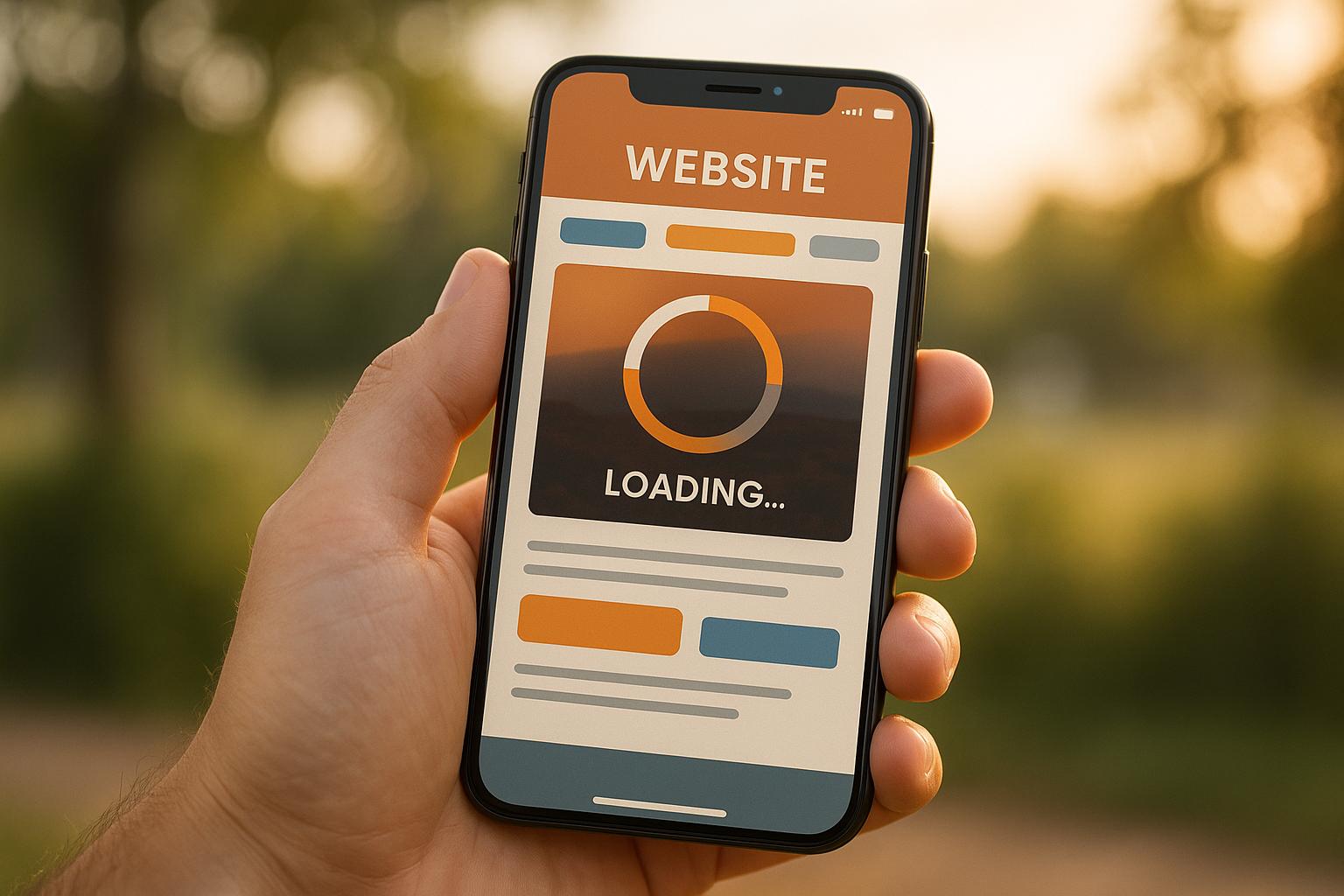Core Web Vitals are critical for mobile SEO. These metrics – Largest Contentful Paint (LCP), Cumulative Layout Shift (CLS), and Interaction to Next Paint (INP) – directly influence how Google ranks your site. They measure loading speed, visual stability, and responsiveness, focusing on real user experience.
Since Google prioritizes mobile-first indexing, your mobile site’s performance is the key factor in determining rankings. Poor scores can lead to higher bounce rates, lower visibility, and missed opportunities, especially for mobile users who expect fast, stable, and responsive websites.
Key Takeaways:
- LCP: Measures loading speed. Aim for under 2.5 seconds.
- CLS: Tracks layout stability. Keep shifts below 0.1.
- INP: Evaluates responsiveness. Target under 200ms.
Improving these metrics involves optimizing images, reducing JavaScript delays, stabilizing layouts, and testing on real devices. Meeting these benchmarks can reduce bounce rates by 24% and boost conversions by 35%. Mobile SEO success depends on delivering a fast, smooth experience tailored to mobile users.
Why Do Mobile Core Web Vitals Underperform Desktop For SEO? – SearchEnginesHub.com
Key Metrics That Affect Mobile SEO Rankings
When it comes to mobile SEO, certain metrics carry significant weight in determining your site’s performance. Each Core Web Vital plays a role in shaping the mobile user experience and directly impacts your rankings. Let’s break down these key metrics and the specific challenges they pose for mobile optimization.
Largest Contentful Paint (LCP)
LCP measures how long it takes for the largest visible element on your page – like a hero image, block of text, or video thumbnail – to fully load. Mobile users often experience slower connections and less processing power, making this metric especially important.
Google’s benchmarks for LCP are straightforward:
- Good: Content loads within 2.5 seconds.
- Needs improvement: Between 2.5 and 4.0 seconds.
- Poor: Over 4.0 seconds.
Slow loading times are a dealbreaker for mobile users, who are often multitasking or need quick access to information. If your content takes too long to appear, users are likely to abandon your site before it even finishes loading.
Some common mobile-specific LCP issues include:
- Oversized images that aren’t compressed for mobile screens.
- Render-blocking JavaScript delaying content display.
- Slow server response times, particularly on cellular networks.
To improve LCP, focus on optimizing the largest element on your page. These efforts are crucial for creating a mobile-friendly experience. Addressing layout shifts is another key aspect of improving usability.
Cumulative Layout Shift (CLS)
CLS measures how much page elements unexpectedly move during user interactions. On mobile devices, where screen space is limited, even small shifts can disrupt the experience and frustrate users.
Here’s how CLS scores are categorized:
- Good: A score of 0.1 or lower.
- Needs improvement: Between 0.1 and 0.25.
- Poor: Above 0.25.
Picture this: You’re about to tap a "Buy Now" button, but an ad loads at the last second, shifting the button out of place and causing you to click the ad instead. That’s exactly the kind of annoyance CLS is designed to prevent. Mobile users are particularly vulnerable to these disruptions because they may start interacting with a page before it’s fully loaded.
The usual culprits behind poor CLS scores on mobile include:
- Images without defined dimensions.
- Web fonts that load late and cause text to shift.
- Dynamically injected content like ads or social media embeds.
Stabilizing your layout is essential to ensure a smooth experience for mobile users. Responsiveness is the final piece of the puzzle.
Interaction to Next Paint (INP)
INP has replaced First Input Delay as the go-to metric for measuring how responsive a site feels. Unlike its predecessor, which only tracked the first interaction, INP evaluates all interactions throughout a user’s visit.
For mobile users, responsiveness is non-negotiable. When someone taps a button or scrolls on their phone, they expect an immediate reaction. Any delay disrupts their experience and can lead to frustration.
INP tracks the time it takes for the browser to respond to a user’s interaction and render the next frame. Here’s how INP scores are classified:
- Good: 200 milliseconds or less.
- Needs improvement: Between 200ms and 500ms.
- Poor: Over 500ms.
Common INP issues on mobile include:
- Unoptimized JavaScript clogging the main thread.
- Complex animations that overwhelm the device’s GPU.
- Third-party scripts competing for resources during interactions.
These metrics have a direct impact on mobile SEO. Sites that meet Core Web Vitals thresholds see 24% lower bounce rates and 35% higher conversion rates compared to those that don’t. For mobile users, who are often more goal-oriented, these improvements are even more critical.
As of July 2025, 44% of WordPress sites achieved good Core Web Vitals scores on mobile devices. Additionally, 60.1% of pages in the top 1,000 origins boast good LCP scores on mobile. These stats highlight the untapped potential for businesses that prioritize mobile optimization. By addressing these metrics, you can significantly improve both user experience and SEO performance.
How to Optimize Core Web Vitals for Mobile Devices
Improving Core Web Vitals for mobile devices isn’t just about better SEO – it’s about creating a smoother experience for users navigating smaller screens, slower networks, and less powerful devices. Let’s dive into practical strategies to make your mobile site shine.
Improving Mobile Loading Performance
Speed is everything on mobile. To get your content loading faster, focus on the biggest culprits slowing things down – like heavy images and inefficient scripts.
- Optimize your images. Images often take up the most bandwidth. Use responsive images with the
srcsetattribute to deliver sizes that fit the screen. Save even more bandwidth by switching to WebP, which can shrink file sizes by 25–35% without losing quality. - Use lazy loading. Don’t load all images at once. With the
loading="lazy"attribute, browsers can defer loading images until they’re actually needed. - Defer non-critical JavaScript. Separate essential scripts from non-essential ones. Load the critical code first, and defer the rest until after the page has rendered. Tools like code-splitting can help streamline this process.
- Speed up your server. Mobile users often face slower connections, so server response times matter. A Content Delivery Network (CDN) can serve content from servers closer to users, while Gzip compression can shrink file sizes.
- Preload important resources. Use
<link rel="preload">to prioritize loading essential assets, like fonts or hero images, right at the start. This can significantly improve Largest Contentful Paint (LCP) scores.
Improving Visual Stability
A page that jumps around as it loads is frustrating, especially on mobile. Keeping your layout steady is key to a good user experience.
- Define dimensions for media. Always set width and height attributes for images, videos, and iframes. This prevents layout shifts by reserving space before the content loads. CSS aspect-ratio properties are great for maintaining proportions across devices.
- Plan for dynamic content. Ads, social media embeds, or user-generated content can disrupt layouts. Use placeholders with fixed dimensions to avoid unexpected shifts.
- Preload fonts smartly. Fonts can cause text to jump when they load. Use
font-display: swapto show fallback text first, and preload critical fonts to reduce delays. - Avoid injecting content above the fold. Adding elements above existing content can disrupt users. Place dynamic content in designated areas, like below the fold, to avoid interruptions.
- Test on real devices. Layout issues can vary across screen sizes and connection speeds. Testing on actual mobile devices helps identify and fix these problems.
Improving Interactivity on Mobile
Once loading and layout are optimized, it’s time to focus on interactivity. Mobile users expect quick responses, and delays can ruin the experience.
- Reduce main thread blocking. The main thread handles user interactions, so keep it free. Break long JavaScript tasks into smaller chunks using
setTimeout()orrequestIdleCallback()to allow the browser to process interactions in between. - Streamline third-party scripts. Scripts like social widgets or ads can slow things down. Load them asynchronously with
asyncordefer, and use a tag management system to control their timing. - Fine-tune event handlers. Avoid heavy operations tied to scroll, resize, or touch events. Use debouncing or throttling to limit how often these handlers run. For touch events, passive listeners can improve scrolling performance.
- Simplify your HTML structure. Deeply nested elements can slow rendering. Use cleaner HTML and rely on CSS Grid or Flexbox for layouts instead of overly complex div structures.
- Optimize animations. Smooth animations are great, but poorly executed ones can hurt performance. Stick to animating transforms and opacity rather than layout properties like width or height. Hardware acceleration with
transform3d()orwill-changecan make animations smoother. - Test under realistic conditions. Use Chrome DevTools to simulate slower devices and networks. This helps pinpoint where interactions might lag on lower-end phones.
Mobile users often face unique challenges – they’re multitasking, on slower networks, and using less powerful devices. By prioritizing these techniques, you’ll not only meet Core Web Vitals benchmarks but also deliver a seamless, enjoyable experience tailored to mobile users.
Mobile vs Desktop Core Web Vitals Performance
Core Web Vitals behave differently on mobile and desktop platforms, which directly influences SEO strategies. While the metrics themselves – such as Largest Contentful Paint (LCP), Cumulative Layout Shift (CLS), and Interaction to Next Paint (INP) – remain consistent, the challenges and methods for optimizing these metrics vary significantly between devices due to hardware and network differences.
Mobile vs Desktop: Key Differences
Mobile and desktop environments each present unique challenges that impact Core Web Vitals performance. Differences in hardware capabilities, network conditions, and user behavior create distinct optimization needs for each platform.
One major factor is device hardware. Mobile devices often have limited processing power, less RAM, and slower graphics capabilities compared to desktops. These limitations make tasks like JavaScript execution and rendering slower, while also requiring stricter memory management.
Network connectivity is another significant factor. Desktop users typically benefit from stable broadband connections with lower latency. In contrast, mobile users often contend with fluctuating cellular networks, slower speeds, and higher latency, all of which can negatively impact page load times and overall performance.
User expectations also vary. Mobile users demand near-instant responses despite the technical constraints of their devices, whereas desktop users tend to be more forgiving of slight delays. This creates a unique challenge where the more constrained platform must meet higher user demands.
| Factor | Mobile Challenges | Desktop Challenges |
|---|---|---|
| Processing Power | Limited CPU, slower JavaScript execution | Powerful processors, faster rendering |
| Memory | 2-8GB RAM, strict memory management | 8-32GB+ RAM, better memory handling |
| Network | Variable 3G/4G/5G, higher latency | Stable broadband, lower latency |
| Screen Size | Smaller viewports, touch interactions | Larger screens, mouse precision |
| Battery Life | Power consumption concerns | Unlimited power supply |
| Loading Expectations | Instant responses expected | More patience for complex content |
While Google’s Core Web Vitals benchmarks – LCP under 2.5 seconds, CLS below 0.1, and INP under 200 milliseconds – apply to both platforms, mobile sites often struggle more to meet these thresholds due to hardware and network constraints. Mobile users prioritize faster initial loading, while desktop users focus more on sustained performance.
Mobile-First Optimization Methods
Google’s shift to mobile-first indexing in March 2021 fundamentally changed how websites should approach Core Web Vitals optimization. Now, Google primarily evaluates a site based on its mobile performance, regardless of whether the majority of traffic comes from desktop users. This means that optimizing for mobile is no longer optional – it’s a critical part of any SEO strategy. Poor mobile Core Web Vitals can negatively impact rankings across all devices.
Progressive enhancement is a key principle for mobile-first optimization. Start by creating a lightweight, fast-loading mobile experience that meets Core Web Vitals benchmarks. Once the mobile foundation is solid, additional features can be layered in for larger screens and more powerful devices.
Resource prioritization becomes essential in this approach. Key resources – like above-the-fold content, essential CSS, and primary navigation – should load first for mobile users. Features that are more relevant to desktop experiences can be deferred without affecting mobile performance.
Touch-first design is another critical consideration. Mobile interfaces require larger touch targets, which can influence layout stability (CLS) if not carefully planned. Similarly, interactive elements need to respond quickly to touch inputs to maintain a smooth user experience and meet INP benchmarks.
Network-aware optimization is vital for mobile performance. Techniques like adaptive loading based on connection speed, using service workers for offline functionality, and prioritizing critical content delivery can significantly improve Core Web Vitals for mobile users.
Finally, the testing and monitoring process must align with a mobile-first mindset. Instead of relying solely on desktop browser simulations, it’s important to test performance on actual mobile devices. Monitoring tools should focus on mobile Core Web Vitals, and fixing mobile performance issues should take precedence over desktop concerns.
Adopting a mobile-first approach means rethinking traditional web development processes. Rather than building for desktop and adapting for mobile, successful websites now prioritize mobile constraints during development and enhance functionality for desktop users afterward. This strategy ensures compliance with Google’s mobile-first indexing requirements and delivers a better experience for users across all devices.
Aligning Mobile SEO with Core Web Vitals
Core Web Vitals have become a key factor in achieving success with mobile SEO. With Google’s mobile-first indexing in play, how well your site performs on these metrics directly impacts its visibility in search results. This approach emphasizes prioritizing mobile performance, building on earlier strategies to ensure a seamless experience that works both technically and for real users.
The connection between Core Web Vitals and mobile SEO extends beyond hitting technical targets. It’s about crafting experiences that satisfy both search engine algorithms and user expectations. On mobile devices, issues like slow loading times, shifting layouts, or delayed interactions are even more noticeable. When your site loads quickly, stays visually stable, and responds instantly to user actions, you’re addressing the factors that search engines reward – and users appreciate.
To stay ahead, regular monitoring of Core Web Vitals is crucial. These metrics can shift due to changes like traffic surges, content updates, third-party scripts, or hosting adjustments. Conducting frequent audits, especially during major site updates, ensures your optimizations remain effective.
Taking an incremental approach to improvements is often the most practical path to long-term success. Start by fixing the pages with the worst performance, then expand your efforts to optimize the entire mobile experience. Small adjustments – like compressing images more effectively, simplifying scripts, and ensuring stable layouts – can lead to noticeable gains in rankings.
Mobile users expect fast load times and smooth interactions, which makes optimizing Core Web Vitals essential not just for SEO but also for user satisfaction. Sites that excel in these areas frequently see better engagement, lower bounce rates, and higher conversion rates.
In today’s mobile-first world, focusing on Core Web Vitals is more than just an SEO tactic – it’s a strategic business move. Companies that integrate these considerations into their development workflows, content strategies, and performance monitoring processes are setting themselves up for sustained success. This kind of optimization provides a competitive advantage that’s hard to beat.
Continuous improvement is key. By consistently refining your Core Web Vitals performance, you align with the mobile-first approach and position your site for long-term growth. SearchX specializes in technical SEO audits and performance strategies that tie Core Web Vitals improvements to broader SEO goals, helping you boost visibility and achieve measurable business results.
FAQs
What’s the best way to check my mobile site’s Core Web Vitals performance?
To get a clear picture of your mobile site’s Core Web Vitals, there are several tools you can rely on for detailed performance insights. Google PageSpeed Insights is a solid place to begin. It breaks down metrics like Largest Contentful Paint (LCP), Cumulative Layout Shift (CLS), and First Input Delay (FID) while offering practical tips for improvement. Another option is WebPageTest, which mimics real-world conditions to evaluate mobile performance. For ongoing tracking, GTmetrix is a useful tool that monitors Core Web Vitals over time and pinpoints areas needing attention.
These tools are invaluable for uncovering issues that impact mobile user experience and SEO rankings. By honing in on Core Web Vitals, you can enhance your site’s usability and boost its performance in search results – a crucial factor in the U.S., where mobile browsing dominates online activity.
What mistakes should I avoid when optimizing Core Web Vitals for mobile SEO?
When working on improving Core Web Vitals for mobile SEO, it’s important to steer clear of these common mistakes:
- Focusing too much on one metric: Zeroing in on a single metric, like Largest Contentful Paint (LCP), while ignoring others such as First Input Delay (FID) or Cumulative Layout Shift (CLS), can create an uneven user experience. All metrics need attention for a well-rounded approach.
- Overlooking mobile performance: Optimizing exclusively for desktop and ignoring mobile-specific challenges can hurt your rankings, especially since most people access websites via mobile devices.
- Skipping real user data: Relying only on lab-generated data instead of real-world user metrics can lead to misleading conclusions. Real user data provides a clearer picture of actual performance.
Other common missteps include failing to optimize images, not minimizing third-party scripts, and neglecting regular performance checks. The key is to take a balanced approach, addressing all Core Web Vitals metrics to ensure a smoother experience for mobile users.
How does improving Core Web Vitals enhance mobile user experience and boost conversion rates?
Improving Core Web Vitals plays a key role in creating a better mobile user experience. By focusing on faster page loads, smoother interactions, and stable content display, you make it easier for users to browse your site without frustration.
A well-performing mobile site encourages visitors to stay longer, engage with your content, and take meaningful actions – whether that’s making a purchase or signing up. This not only boosts conversion rates but also builds trust, as users appreciate a site that’s quick, dependable, and easy to navigate.




